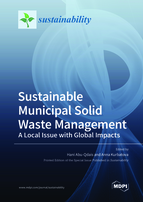Sustainable Municipal Solid Waste Management: A Local Issue with Global Impacts
A special issue of Sustainability (ISSN 2071-1050). This special issue belongs to the section "Resources and Sustainable Utilization".
Deadline for manuscript submissions: closed (31 March 2022) | Viewed by 39774
Special Issue Editors
Interests: integrated solid waste management; circular economy; application of artificial intelligent in solid waste management
Interests: global climate change; waste management; integrated water resources management
Special Issue Information
Dear Colleagues,
Gaining and preserving value in solid waste resources are becoming increasingly relevant global challenges. Local socio-economic specificities raise different needs for solid waste management and engender diverse strategies in terms of waste reduction, collection systems, recovery and recycling. In this sense, it is crucial that new policies in view of Circular Economy are correctly contextualized. This issue focuses on sustainable municipal solid waste management in different contexts (i.e., urban vs. rural, region-specific, etc.).
As municipal solid waste management has become an area of increasing interest and concern, our goal is to publish articles on recent research concepts, models and tools for sustainable municipal solid waste management. We welcome original research as well as review papers in relevant areas, including: indicators for assessing the sustainability of municipal solid waste management systems, material flow analysis and life cycle assessment, municipal solid waste management logistics, best available technologies in municipal solid waste management, use of artificial intelligence in solid waste management, municipal solid waste treatment technologies, profitability assessment in municipal solid waste management, economic aspects and tools of solid waste management and regional case studies. This issue is aiming to stimulate the consolidation of scientific potential in the field of sustainable municipal waste management by publishing state-of-the art studies that will lead to a deep understanding of the structure of the municipal solid waste management systems according to the principles of a circular economy.
Prof. Dr. Hani Abu-Qdais
Prof. Dr. Anna Kurbatova
Guest Editors
Manuscript Submission Information
Manuscripts should be submitted online at www.mdpi.com by registering and logging in to this website. Once you are registered, click here to go to the submission form. Manuscripts can be submitted until the deadline. All submissions that pass pre-check are peer-reviewed. Accepted papers will be published continuously in the journal (as soon as accepted) and will be listed together on the special issue website. Research articles, review articles as well as short communications are invited. For planned papers, a title and short abstract (about 100 words) can be sent to the Editorial Office for announcement on this website.
Submitted manuscripts should not have been published previously, nor be under consideration for publication elsewhere (except conference proceedings papers). All manuscripts are thoroughly refereed through a single-blind peer-review process. A guide for authors and other relevant information for submission of manuscripts is available on the Instructions for Authors page. Sustainability is an international peer-reviewed open access semimonthly journal published by MDPI.
Please visit the Instructions for Authors page before submitting a manuscript. The Article Processing Charge (APC) for publication in this open access journal is 2400 CHF (Swiss Francs). Submitted papers should be well formatted and use good English. Authors may use MDPI's English editing service prior to publication or during author revisions.
Keywords
- municipal solid waste management
- zero waste
- green technologies
- circular economy
- material flow analysis
- life cycle assessment







